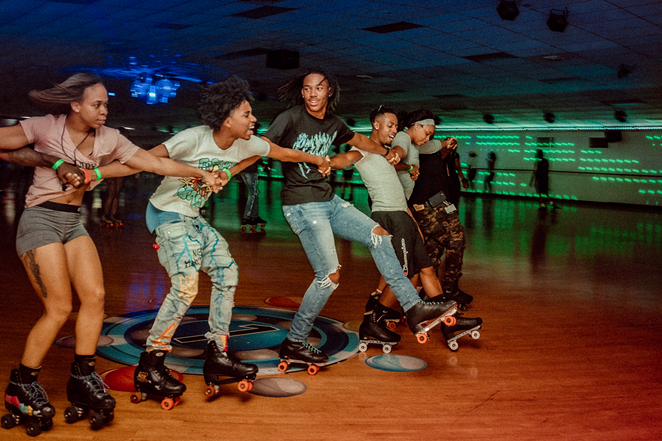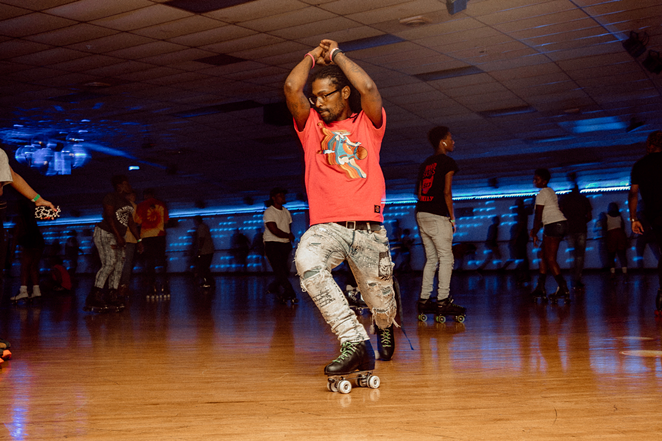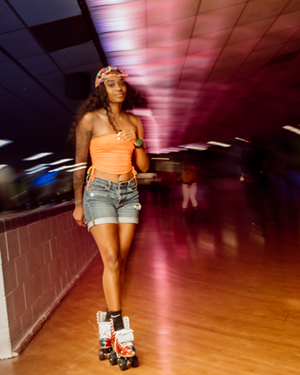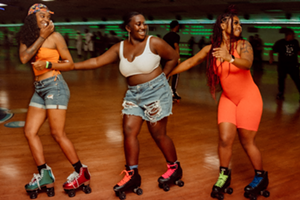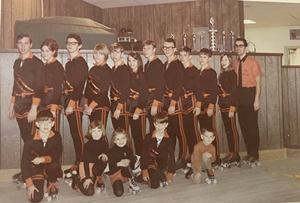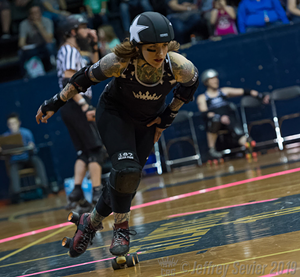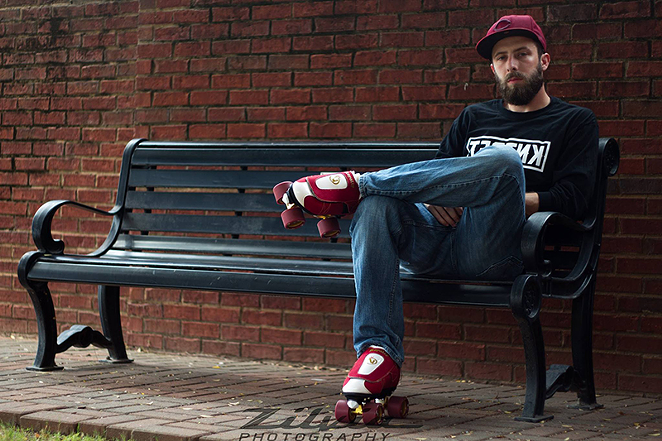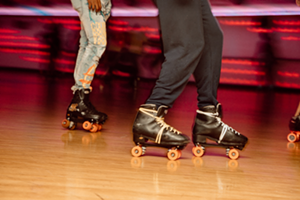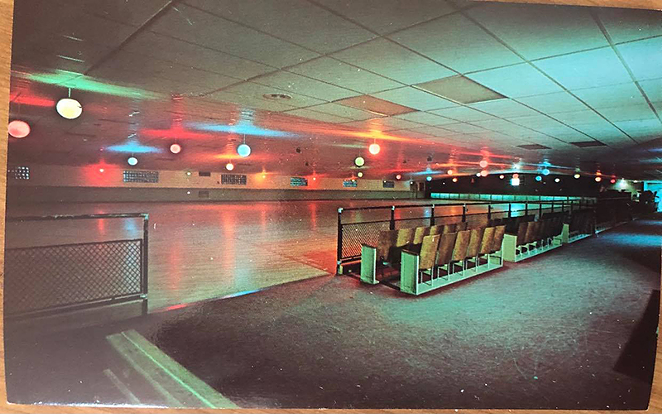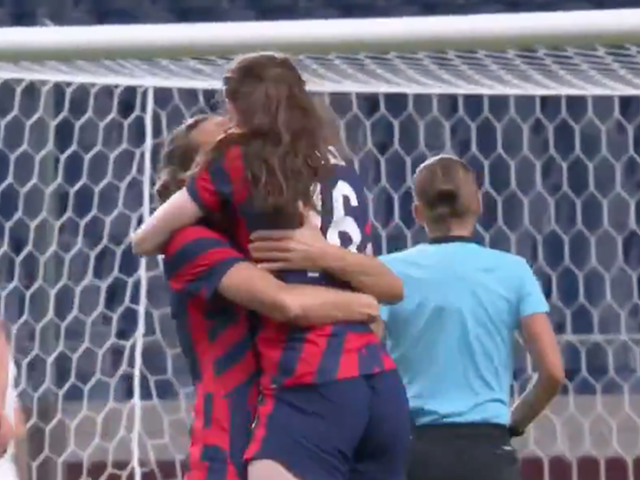Ever since a handful of videos went viral on social media, roller skating seems to be everywhere.
It’s hard to say exactly which post started it. There’s the TikTok of actress Ana Coto cruising on skates to music by J.Lo from last April, which had more than 14 million views by summer.
Then there are skaters like Berlin-based Oumi Janta, who posts her smooth jam-skating moves and whose Instagram account grew from around 60,000 followers to 951,000 followers in the last year.
And now roller skating is reaching audiences of every persuasion, appearing in ads, on the streets and trails, at the skate parks and stitched onto fast-fashion pieces.
But long before the social media algorithm started highlighting skate videos, Cincinnati has been home to thousands of passionate skaters who have been keeping the community of eight wheels alive, and — in the Black community — fighting for their right to enjoy it.
Keeping the Legacy Alive
On Thursday nights around 9 p.m., the parking lot at The Place Cincy in Colerain Township starts to fill up as skaters begin arriving for the skate night for people ages 30 and up — one of just two adult-only skate nights hosted at the roller rink (those 21 and older arrive on Wednesdays). Inside, a DJ spins old-school R&B, and a predominantly Black community of devoted skaters lace up their boots for a night on the floor.
The Place is owned by Brian Liette, whose parents bought the rink when he was 17 years old.
“My grandparents had a roller rink in Salina, Ohio — just a little farm town roller rink, and they bought that in 1950,” Liette says. “Mom and dad bought this in ’83. I literally grew up in a roller rink.”
It’s normal, at least in the Cincinnati region, for rinks to run in the family. The Harper family opened its first rink — The Ritz in downtown Cincinnati — in 1965. Since then, three generations of Harpers have owned and operated multiple rinks around town. Three of them — Castle Skateland, Florence Fundome and Beechmont Rollarena — are still going strong.
Liette already had been hosting regular adult nights at The Place for the 21-and-up crowd, but when the pandemic forced capacity restrictions on indoor events, he saw the need for a second adult skate night. Now, dozens of skaters come each week to skate at the only public rink within the Cincinnati city limits.
“I’ve known a lot of these guys for years,” Liette says of his regular skaters. “A lot of the people on Thursday night I’ve known them, seriously, 20 years.”
One of the regular Thursday night skaters is a woman named Brittney Smith, who studies history in the doctoral program at the University of Cincinnati and is working toward opening what will be Cincinnati’s first Black, woman-owned skating rink.
“I love history, and I love what skating rinks have meant to the Black community,” Smith says. “Not just because Black joy and Black recreation matter, but because of what else it offers in terms of your health and your wellness.”
After studying, working, traveling abroad and devoting years to raising a family, Smith found an opportunity for self-care in skating.
“When I found skating, I just learned to breathe again,” Smith says. “I hadn’t breathed for a long time. I learned to sleep again.”
Smith recently finished the MORTAR program, a 15-week course that helps aspiring entrepreneurs prepare to launch their businesses, and is working carefully to develop the right strategy for her roller rink. When she opens her rink, she wants it to be in the heart of the city, and she wants it to tell a story.
“My rink is about history, too,” Smith says. “I’m thinking about a mural that helps explain...the evolution of skating and how it came to be that (the Black community) could even step foot in here.”
Smith plans for her rink to show the significance of skating rinks in the Civil Rights movement — one of the first sit-ins took place at White City Roller Rink in Chicago — and in other areas of Black history, such as Hip Hop culture. She also wants to emphasize how skating brings people together.
“The rink is a community center, you know. It’s for everybody, and it’s the one place where we can all come together on a single issue. It’s not Congress,” Smith says with a laugh. “We can all work together, and we can all just skate, and nothing else matters. We need those spaces.”
Although Smith has the option to lace up her skates and hit the rink floor with friends every week at The Place Cincy, this simple pleasure was unavailable to the Black community just decades ago. When recreational spaces were still segregated, white-only rinks forced Black people to find their own spaces. They built rinks in basements of churches or found spaces outside because they were denied the capital needed to start their own rink.
“You had this multi-purpose use concept,” Smith says. “We can’t open (a rink) because we can’t get to the banks, we can’t get access to the funds.”
A number of makeshift rinks like these remain around Cincinnati, each one a relic of segregation and a reminder of how important roller skating has been for the Black community throughout the years.
Even today, some rinks in America enforce rules that are born out of racism, like bans against fiberglass wheels or slick micro wheels that many Black skaters use in a certain style of skating. Although most local rinks say they don’t have rules like those, Smith still looks forward to opening her own space.
“What about inclusivity?” Smith asks. “What about learning to live and work together in harmony and appreciate everything and everybody? Thank god for people like Linda Rall (of Middletown Skateway) and Mike (Penrod) at Orbit (Fun Center in Huber Heights) and Brian (Liette) at The Place who understand.”
Roughing Things Up
Kathy Kissing is another frequent attendee of the Thursday night skates at The Place. She is the daughter of Tony Kissing, a renowned roller speed skating coach who helped popularize the sport in Cincinnati. Two years ago, Tony Kissing was inducted into the Roller Skating Hall of Fame in Lincoln, Nebraska, for his time as a coach, during which he helped train almost 40 national champions.
“Speed skating, it was big,” Kathy Kissing says. “Everybody had a team.”
Kissing can’t remember a time when her dad wasn’t working with his speed skating teams. While her dad was coaching, her mom was working at the rink.
“I probably crawled, and then had skates on when I was crawling, and learned how to walk and skate at the same time,” Kissing says, laughing.
When Kissing started competing at age 7, speed skating happened on quad skates — boots that have two wheels in the front and two in the back. Today, speed skaters use inline skates, where four wheels are lined up single file under each shoe.
“In the ’70s, they started turning it over to plastic wheels (instead of wood), which sort of slowed it down in some ways,” Kissing says. “As the equipment sort of evolved, it became more of an inline sport.”
Kissing wasn’t as fond of speed skating on inlines, and at age 14, she gave it up. She graduated high school, went to college in New York and started a family. Years later, she received a call from her dad about a new local sports team that practiced on quad skates.
“They had a call out to start roller derby, and my dad called me and told me about it,” Kissing says. “I said, ‘Well dad, I'm 41. I don’t really know if I need to get involved,’ and he said, ‘You’re right, Kathy. You can’t do it,’ and he hung up on me. So of course I started up at the first practice.”
Kissing was one of the first skaters on the Cincinnati Rollergirls (CRG) team, along with Lauren Bishop, the team’s current owner. The CRG became the area’s first roller derby team in 2005. In 2011, Kissing and Bishop started the Cincinnati Junior Rollergirls for skaters ages 8-17.
Unlike Kissing, Bishop didn’t have any family to recruit her for roller skating sports. She caught wind of the budding team when another derby member read a post Bishop wrote about the AMC reality series Rollergirls for her pop culture blog with The Cincinnati Enquirer. The team invited Bishop to join, and she went for it.
“It really wasn’t until I became involved with roller derby that I felt like I found my people,” Bishop says. “Cincinnati feels like home now because of this thing I became involved in.”
In the early days, another one of Tony Kissing’s speed skaters came on to help coach the young roller derby team. Marcia Yager had started speed skating under his guidance as an early teen after losing her father. She earned 15 national titles, skated downhill inline at the X-Games, and ultimately built a life prioritizing fitness and nutrition. That made Yager an obvious choice for building a strong team of skaters for CRG.
“Honestly, I just really taught those girls how to skate,” Yager says. “It was really great to be able to help those girls find something new and different — a community they could belong to.”
Since its inception, a lot has changed for CRG. In the beginning, the league created home teams that played against one another in a casual setting. It was more for fun and less of a serious athletic pursuit. Bishop describes it as having a “Punk Rock, kind of DIY aesthetic” and recalls recruiting people in bars that looked the part, often approaching people that were tough, rockabilly and tattooed.
“They did a lot of partying and ate a lot of donuts and came to practice late,” Yager says. “If they wanted to get better, that just wasn’t going to work.”
In 2008, CRG had its first season as a member of the Women’s Flat Track Derby Association, the international governing body for flat track roller derby. Both the A-team — known as the Black Sheep — and the B-team — the Violent Lambs — participate in inter-league bouts.
But back in 2006, some early members of CRG left to start their own league, Black-n-Bluegrass Roller Girls, in Northern Kentucky. Although the two leagues didn’t quite get along at first, coaches, players and priorities have shifted over the years. The leagues began playing against one another once a year in a tradition dubbed the “Crosstown Knockdown.” This game continues to bring awareness to the two different local leagues and occurs in addition to their inter-league seasons.
“It just sort of evolved over the years into the much more competitive sport it is today,” Bishop says. “And then, you know, more actual athletes started joining.”
For its 2020 season — canceled due to the pandemic — CRG was set to play at Xavier’s Cintas Center after three seasons at Schmidt Memorial Fieldhouse, replacing the team’s previous home at the now-defunct Cincinnati Gardens. The team recently returned to practice for the first time since last year but hasn’t yet scheduled a return season. When it finally gets around to playing at Cintas Center, Bishop hopes that the team will inspire more sports fans to start following CRG
“Cincinnati’s a sports town, obviously,” Bishop says. “We wanted to appeal to other sports fans but at the same time not be exactly like every other sport. We wanted to, like, keep the (derby) names. We wanted to keep some of the things that made derby different and special, while at the same time be taken seriously as a sport.”
Roller derby isn’t the only athletic game played on eight wheels in this sport-enthused region. In Evendale, Sports Plus organizes and hosts inline hockey leagues throughout the week for all ages and skill levels. Across the river, the Covington Street Hockey League plays at the rink in Barb Cook Park.
Finding a Community
At Castle Skateland in Loveland, skaters like David “Smitty” Smith are developing their physical skills in jam skating, a style that combines dance, gymnastics and lots of impressive footwork. Smitty grew up skating at Castle Skateland and has spent much of his life with eight wheels under his feet. He says he’s traveled for performances and competitions, plus he’s taught skaters worldwide over Zoom.
“I have some kids that I’ve been skating with since they were 5 or 6 years old,” Smitty says. “Now they’re going into college, and they are sponsored by national companies and travel with me to events, and they teach their own classes.”
Dylan Morton is another sensationally talented skater that calls Castle Skateland his home rink. Morton started skating when he was 10 and has skated with Smitty since the beginning.
“Growing up with a broken household, and having to move so many times as a young kid, I turned to skating to comfort,” Morton says. “(It) led me in a direction that I didn’t know was possible.”
Today, Morton is sponsored by Riedell, one of the leading manufacturers of roller skates. He does his own choreography and shares a lot of his moves on his Instagram account (@dylan__morton). Both Morton and Smitty (@smittyonskates) have strong followings on social media, the very platforms that have caused the latest craze in quad skating.
“I’ve been fighting for roller skating for pretty much my entire life,” Smitty says. “I knew skating was going to have its time around. I had no idea that a few girls on TikTok was what was going to make it happen.”
Although a single social media post like Coto’s viral TikTok leaves so much of the story of skating untold, the platform works well to bring awareness to community and history. Both things are a priority for Gabrielle Larkin, who started Cincinnati Skate Collective (CSC) last year. Larkin has skated with CRG since 2018.
“I noticed at the time that there were a lot of different people skating in different ways, but there was nothing tying them together,” Larkin says. “It kind of seemed like a lot of people were trying to find a community but there wasn’t any representation.”
CSC holds weekly meetups for quad skaters and inline skaters of all backgrounds at a range of locations, from skate parks to outdoor rinks to trails. Larkin shares events on social media and uses the platforms to help teach skaters about the history of skate culture.
“Trying to unite all sides of the skating world with an underlying respect and honor for the history, I think, is super important,” Larkin says.
CSC also has a Facebook group, where more than 600 skaters from the Cincinnati region share tips, videos and invitations to skate. The group is predominately white, but Larkin is working on making meetups more welcoming and accessible to skaters of all backgrounds and styles.
Her current mission is to revitalize the outdoor rink at Sawyer Point. This would include resurfacing the space to be smoother and more skateable for those who use smaller and harder wheels, which are common in the Black skate community.
“That kind of surface is more accessible and more skateable for people who are skating on those kinds of wheels,” Larkin says. “That‘s another reason why I really want that space to be resurfaced. I’ve been talking to a lot of Black skaters trying to figure out how we can kind of bridge that gap.”
In the last year and a half, roller skating has entered the collective conscience through social media, but Cincinnatians found themselves on eight wheels long before that. Now it’s about continuing to build safe, welcoming spaces for any and all who want to experience the joy of skating.
“It is a church, it is a movement,” Smith says. “It is about people, it is about love and unity. Especially in this climate we’re in now, politically, humanity just needs a space to breathe. The planet just needs a break. We can get it in the skating rink.”
Indoor Rinks
- Beechmont Rollarena 3988 Commercial Blvd., Beechmont, beechmontrollarena.com
- Castle Skateland 980 Loveland Madeira Road, Loveland, castleskateland.com
- Florence Fundome 7864 Commerce Drive, Florence, florencefundome.com
- Middletown Skateway 2514 N. Verity Parkway, Middletown, skateway.com
- Orbit Fun Center 5001 Nebraska Ave., Huber Heights, orbitfuncenter.com
- The Place Cincy 3211 Lina Place, White Oak, theplacecincy.com
Outdoor Rinks
- Riverfront Outdoor Rink 705 E. Pete Rose Way, Sawyer Point Park, Downtown, cincinnatiparks.com
- Warsaw Federal Skate Park 640 Evans St., Evans Recreation Area, Lower Price Hill
Meetup Groups
- Cincinnati Skate Collective Follow @cincinnatiskatecollective on Instagram and Facebook for weekly meetups
- CIB Cincinnati Follow @CIBcincinnati for regular skate park meetups
- Girls & Queers Skate Takeover @sk8takeover
Hockey
- SportsPlus Inline Hockey 10765 Reading Road, Evendale, inline.me
- Covington Street Hockey covingtonstreethockeyleague.com, @cshlbubs
Roller Derby
- Cincinnati Rollergirls cincinnatirollergirls.com
- Black-n-Bluegrass Roller Girls black-n-bluegrass.com
Sign up for our weekly newsletters to get the latest on the news, things to do and places to eat delivered right to your inbox.

